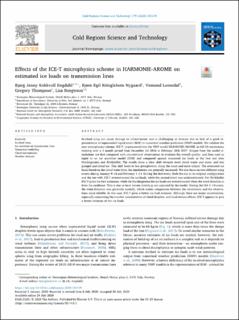| dc.contributor.author | Engdahl, Bjørg Jenny Kokkvoll | |
| dc.contributor.author | Nygaard, Bjørn Egil Kringlebotn | |
| dc.contributor.author | Losnedal, Vemund Wilson | |
| dc.contributor.author | Thompson, Gregory | |
| dc.contributor.author | Bengtsson, Lisa | |
| dc.date.accessioned | 2021-03-29T09:03:59Z | |
| dc.date.available | 2021-03-29T09:03:59Z | |
| dc.date.created | 2021-01-05T12:14:03Z | |
| dc.date.issued | 2020 | |
| dc.identifier.citation | Cold Regions Science and Technology, 2020. 179, 103139 | en_US |
| dc.identifier.issn | 0165-232X | |
| dc.identifier.uri | https://hdl.handle.net/11250/2735894 | |
| dc.description.abstract | In-cloud icing can cause damage to infrastructure and is challenging to forecast due to lack of a good representation of supercooled liquid water (SLW) in numerical weather prediction (NWP) models. We validate the new microphysics scheme, ICE-T, implemented into the NWP model HARMONIE-AROME, in full 3D simulations running over a 3 month period from December 1st 2016 to February 28th 2017. Output from the model simulations are first compared with conventional observations to evaluate the overall quality, and then used as input to an ice accretion model (IAM) and compared against measured ice loads at the two test sites Hardingnuten and Ålvikfjellet. The results show a clear shift towards more cloud water and snow, and less graupel and cloud ice. This shift leads to less precipitation along the coast and more inland. The estimated ice loads based on the cloud water from the simulations are generally increased. We also focus on two different icing events during January 9–18 and February 1–14. During the first event, both the run in its original configuration and the run with ICE-T overestimated the ice loads, while the second event was underestimated. For Ålvikfjellet ICE-T gives the best estimates, while for Hardingnuten the ice loads are overestimated when the wind direction is from the southeast. This is due to local terrain shielding not captured by the model. During the Feb 1–14 event, the wind direction was generally easterly, which makes comparison between the simulations and the observations more reliable. In this case, ICE-T gives a better ice load estimate. Although there are major uncertainties, especially concerning the number concentration of cloud droplets, and local terrain effects, ICE-T appears to give a better estimate of the ice loads. | en_US |
| dc.language.iso | eng | en_US |
| dc.rights | Attribution-NonCommercial-NoDerivatives 4.0 Internasjonal | * |
| dc.rights.uri | http://creativecommons.org/licenses/by-nc-nd/4.0/deed.no | * |
| dc.title | Effects of the ICE-T Microphysics Scheme in HARMONIE-AROME on Estimated Ice Loads on Transmission Lines | en_US |
| dc.type | Journal article | en_US |
| dc.description.version | publishedVersion | en_US |
| dc.source.volume | 179 | en_US |
| dc.source.journal | Cold Regions Science and Technology | en_US |
| dc.identifier.doi | 10.1016/j.coldregions.2020.103139 | |
| dc.identifier.cristin | 1865474 | |
| dc.relation.project | Norges forskningsråd: 244106 | en_US |
| dc.source.articlenumber | 103139 | en_US |
| cristin.ispublished | true | |
| cristin.fulltext | original | |
| cristin.qualitycode | 2 | |

